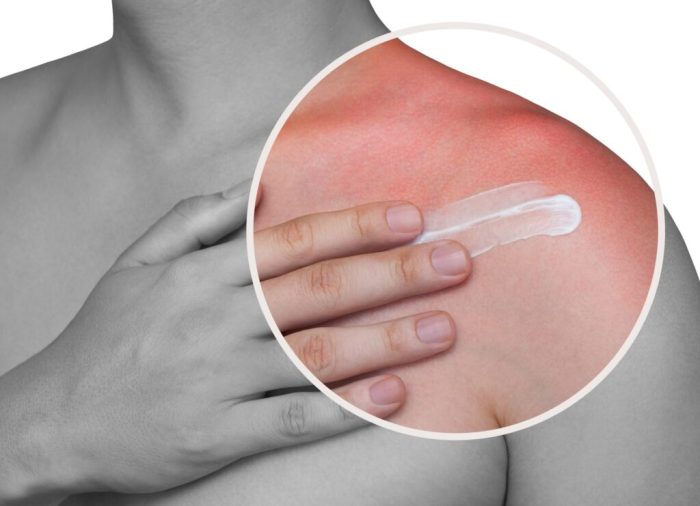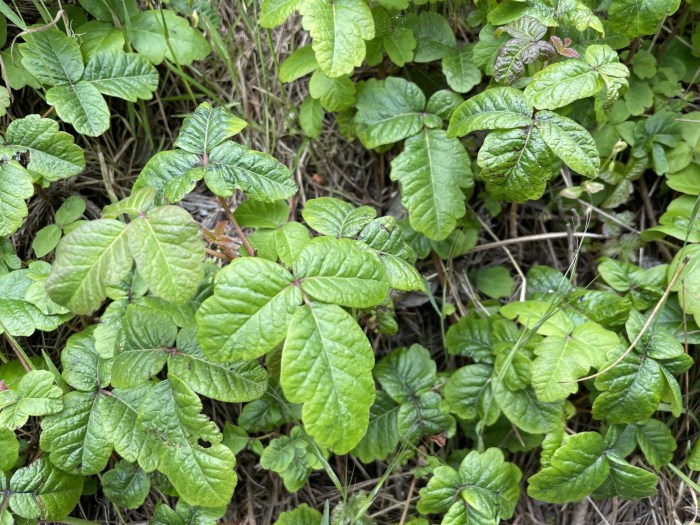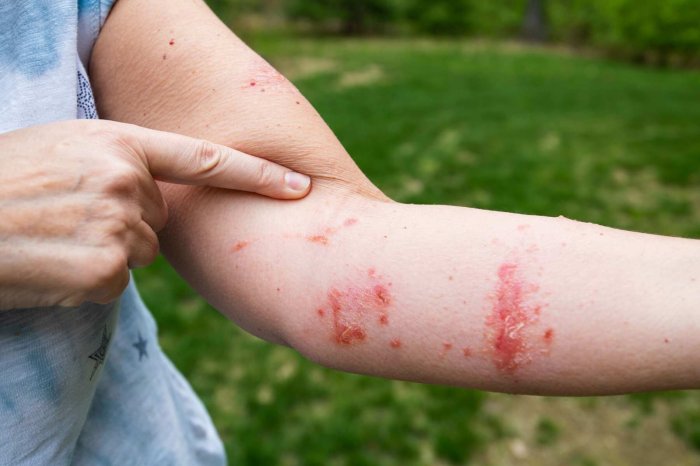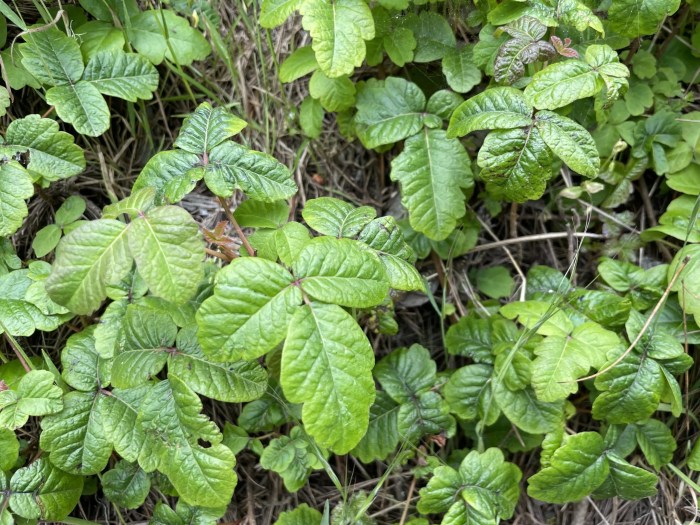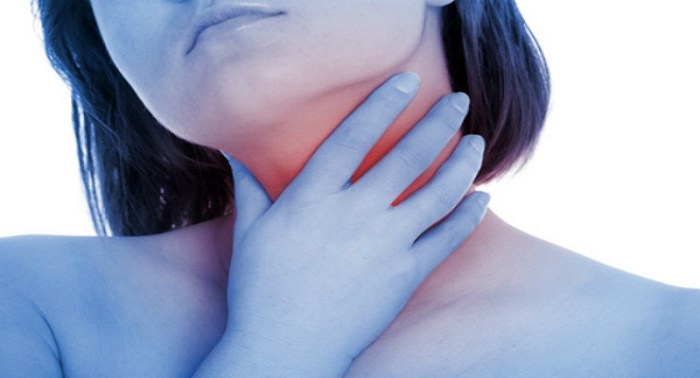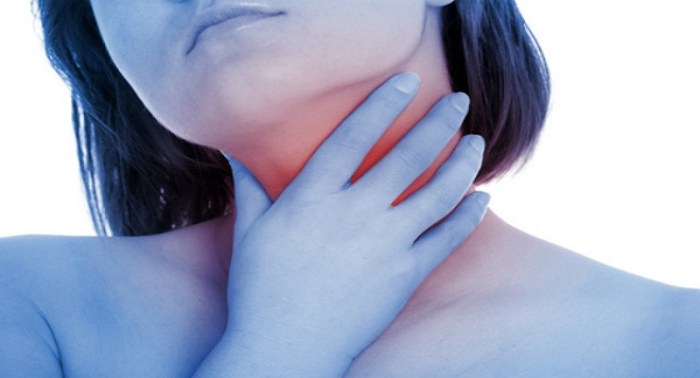White rash on skin can be a perplexing issue, often causing concern and uncertainty. This guide delves into the multifaceted nature of white rashes, exploring potential causes, appearances, diagnostic considerations, treatment options, and preventative strategies. Understanding the different factors contributing to these skin conditions is key to finding appropriate solutions.
From allergic reactions to infections and autoimmune diseases, a variety of medical conditions can manifest as a white rash. This comprehensive guide will equip you with the knowledge to better understand this skin condition, empowering you to seek proper medical advice when needed.
Possible Causes
A white rash on the skin, while seemingly simple, can stem from a variety of underlying medical conditions. Identifying the cause is crucial for effective treatment. Proper diagnosis requires careful consideration of the rash’s appearance, location, and associated symptoms. This section delves into potential causes, ranging from allergic reactions to infections and autoimmune diseases.Understanding the different causes of a white rash is vital for prompt and accurate medical intervention.
A comprehensive approach, involving a detailed medical history, physical examination, and potentially diagnostic tests, is essential for pinpointing the root cause and implementing the appropriate treatment plan.
Potential Medical Conditions
A white rash can be a manifestation of several medical conditions. It’s important to note that this is not an exhaustive list, and a healthcare professional should always be consulted for proper diagnosis and treatment.
- Allergic Reactions: Allergic reactions, ranging from mild to severe, can manifest as a white rash. These reactions can be triggered by various substances, including certain foods, medications, and environmental factors. Common allergic reactions that present with white rashes include contact dermatitis, food allergies, and drug reactions. Contact dermatitis, for example, can manifest as a white, scaly rash in areas of skin contact with an allergen, such as nickel in jewelry.
- Infections: Infections, including bacterial, viral, and fungal infections, can sometimes lead to white rashes. The appearance and distribution of the rash can vary significantly depending on the type of infection. For example, certain viral infections, such as measles, can present with a distinctive rash that progresses through different stages and may appear as white or pale areas on the skin.
Bacterial infections can also present with white or pale areas on the skin, often accompanied by other symptoms, such as fever and localized pain.
- Autoimmune Diseases: Autoimmune diseases, where the body’s immune system mistakenly attacks its own tissues, can sometimes result in white rashes. Conditions like vitiligo, a chronic autoimmune disorder, cause the loss of pigment in the skin, resulting in white patches. This loss of pigment is a direct result of the immune system attacking the melanocytes responsible for producing melanin, the pigment that gives skin its color.
Comparison of Skin Conditions with White Rashes
The following table provides a comparative overview of various skin conditions that can manifest with a white rash. Note that this is not an exhaustive list and individual symptoms may vary.
| Condition | Location | Appearance | Duration |
|---|---|---|---|
| Vitiligo | Anywhere on the body | Smooth, well-defined white patches | Chronic, often progressive |
| Pityriasis alba | Face, arms, and legs | Pale, slightly scaly patches | Usually resolves on its own within a few months |
| Tinea versicolor | Trunk, neck, and upper arms | Round, slightly scaly, white or light brown macules | Chronic, recurring |
| Certain drug reactions | Variable, often widespread | Pale, flat areas of skin | Variable, depending on the drug and individual response |
Appearance and Characteristics

A white rash on the skin can manifest in various ways, making accurate identification and diagnosis crucial. Understanding the appearance, texture, and accompanying symptoms is essential for determining the potential cause and necessary course of action. Accurate descriptions can help healthcare professionals in making informed decisions about appropriate testing and treatment.Recognizing the specific characteristics of a white rash is key to distinguishing between different possible conditions.
This includes not only the visual attributes but also any associated sensations or accompanying symptoms. This information helps in narrowing down potential causes and guiding appropriate medical intervention.
Appearance Variations
White rashes can display a range of appearances. They can be patchy, appearing in isolated areas with clear boundaries. Alternatively, they might be diffuse, covering a large portion of the skin or even the entire body. Localized rashes, conversely, are restricted to a specific area, such as a limb or a particular body part. These variations in appearance provide valuable clues to the underlying cause.
Texture Variations
The texture of a white rash can also provide diagnostic clues. A smooth rash feels uniformly flat, resembling the skin’s normal texture in the unaffected areas. A bumpy rash features small elevations or protrusions on the skin’s surface. A scaly rash, on the other hand, often presents with flaky or dry patches, resembling small scales or flakes of skin.
The texture helps differentiate between various dermatological conditions.
Size and Shape
White rashes can vary significantly in size and shape. They can be small and localized, resembling a coin or a patch, or they can be extensive, covering a large area of the body. The shape might be irregular, circular, or even linear, providing additional diagnostic information. For example, a rash that follows a nerve pathway might suggest a specific underlying condition.
Color Variations
| Color | Description |
|---|---|
| Pure White | A completely white rash with no other visible coloration. |
| Off-White | A pale, whitish hue, often with subtle variations in tone. |
| Grayish White | A white rash with a hint of gray, indicating potential inflammation or other underlying issues. |
| Pinkish White | A white rash with a subtle pink tinge, which may be a sign of inflammation or certain allergic reactions. |
The color of a white rash can sometimes vary from a pure white to a grayish or pinkish hue. Subtle variations in color can be indicative of underlying inflammation or other conditions.
Accompanying Symptoms
A white rash can be accompanied by various symptoms. Itching is a common symptom, causing discomfort and irritation. Pain, ranging from mild to severe, may accompany the rash. Fever can indicate a systemic infection or inflammatory response. Blisters, small fluid-filled sacs on the skin, can accompany some types of rashes.
Other possible symptoms include swelling, redness, and burning sensations.
Diagnostic Considerations: White Rash On Skin
Pinpointing the exact cause of a white rash requires a systematic approach. A doctor will gather a detailed medical history, perform a thorough physical examination, and potentially order various diagnostic tests. Understanding the nuances of different diagnostic methods is crucial for accurate diagnosis and appropriate treatment. The appearance and characteristics of the rash, coupled with the patient’s overall health, play a significant role in determining the most suitable diagnostic path.
Common Diagnostic Tests
A variety of tests can aid in identifying the underlying cause of a white rash. These tests can range from simple blood work to more complex procedures, depending on the suspected cause and the patient’s presentation. The goal is to narrow down the possibilities and ultimately arrive at a definitive diagnosis.
- Blood Tests: Blood tests are frequently used to check for various conditions that can manifest as a white rash. These tests can assess for infections, autoimmune diseases, and other systemic issues. For instance, a complete blood count (CBC) can reveal abnormalities indicative of certain infections, while specific blood tests may detect elevated levels of inflammatory markers suggestive of autoimmune conditions.
Examples include testing for rheumatoid factor or antinuclear antibodies.
- Skin Biopsies: A skin biopsy is a crucial diagnostic tool when the cause of the white rash remains unclear after other investigations. A small sample of skin tissue is taken and examined under a microscope. This allows pathologists to identify specific cellular changes, inflammatory patterns, or the presence of microorganisms that might be the root cause of the rash.
This microscopic examination can differentiate between various types of rashes and identify specific types of fungal or bacterial infections. For instance, a biopsy can differentiate between a fungal infection and a skin condition caused by an allergic reaction.
- Allergy Testing: If an allergic reaction is suspected, allergy testing can pinpoint the specific allergen responsible for the rash. Methods include skin prick tests, patch tests, and blood tests that measure allergen-specific immunoglobulin E (IgE) antibodies. This information is critical in developing appropriate allergy management strategies. For example, if a patient has a white rash after exposure to certain foods or materials, allergy testing can help identify the culprit.
- Microscopic Examination of Skin Scrapings: In cases of suspected fungal infections, microscopic examination of skin scrapings can reveal the presence of fungal hyphae. A doctor might collect a sample of skin scrapings and examine it under a microscope to look for specific fungal structures, which is important for diagnosing fungal infections like tinea versicolor. This is a less invasive approach compared to a skin biopsy.
Doctor’s Evaluation
A doctor’s assessment involves a thorough evaluation of the patient’s medical history, physical examination, and potentially diagnostic tests. The doctor will carefully examine the rash, noting its location, size, shape, and appearance. A complete medical history is essential.
- Medical History: A detailed medical history is critical in understanding the context of the white rash. This includes information about recent illnesses, medications, allergies, and any relevant family history of skin conditions. The doctor will inquire about potential exposures, like contact with plants or chemicals, and any recent travel or new environmental exposures. For example, a patient reporting recent antibiotic use might have a fungal infection, and this is something that the doctor will consider.
- Physical Examination: The physical examination focuses on evaluating the rash’s characteristics. The doctor will examine the skin, checking for any associated symptoms like itching, pain, or blistering. They will assess the overall health and look for any other signs or symptoms that might indicate an underlying condition. For instance, if the patient has other symptoms like fever or joint pain, this could suggest an autoimmune disorder.
Ever noticed a white rash on your skin? It could be a reaction to various things, but sometimes, less obvious factors like heavy metals in your diet might play a role. For example, some studies suggest that dark chocolate, specifically if it’s not sourced responsibly, might contain elevated levels of heavy metals. Understanding the potential impact of things like heavy metals dark chocolate on your skin health is crucial for identifying potential triggers and finding solutions.
This could help you pinpoint whether a dietary change is necessary to resolve the white rash.
Diagnostic Approaches
Different approaches are utilized depending on the type of white rash. A doctor will consider the rash’s appearance, location, and the patient’s medical history to determine the most appropriate diagnostic path.
| Type of Rash | Diagnostic Approach |
|---|---|
| Psoriasis | Often diagnosed based on the characteristic appearance of the rash, along with a thorough medical history and physical examination. Blood tests might be performed to rule out other conditions. |
| Tinea Versicolor | A skin scraping examined under a microscope can often identify the fungal organism responsible for this condition. Blood tests are usually not necessary. |
| Pityriasis Alba | Typically diagnosed based on the characteristic appearance of the rash and a thorough history. Biopsies are usually not required. |
Skin Biopsies
Skin biopsies are a valuable tool in diagnosing various skin conditions. They provide a direct visualization of the skin’s cellular structures and allow for the identification of specific cells, inflammatory changes, or microorganisms. This detailed analysis can help determine the cause of the rash and guide treatment decisions.
Skin biopsies are crucial for diagnosing conditions that cannot be definitively identified through other methods.
Treatment Options
Dealing with a white rash can be frustrating, and the best course of action depends heavily on the underlying cause. Effective treatment often involves addressing the specific trigger, whether it’s a fungal infection, an allergic reaction, or a skin condition like vitiligo. This section explores various treatment options, from topical creams to oral medications and lifestyle adjustments, emphasizing the importance of consulting a healthcare professional for accurate diagnosis and personalized treatment plans.Understanding the root cause of the rash is crucial.
A dermatologist or primary care physician can perform a thorough examination, consider your medical history, and order necessary tests to pinpoint the exact cause. This information is vital for determining the most appropriate and effective treatment strategy.
Topical Treatments
Topical treatments are often the first line of defense for many white rash conditions. These involve applying creams, ointments, or lotions directly to the affected area. Different topical medications target various underlying causes. For example, antifungal creams are frequently used to treat fungal infections, while corticosteroid creams can reduce inflammation associated with allergic reactions or certain skin conditions.
The effectiveness and appropriateness of topical treatments vary depending on the specific cause of the rash.
- Antifungal creams: These medications are typically used to treat fungal infections, like tinea versicolor, which can manifest as a white or light-colored rash. Examples include clotrimazole, miconazole, and terbinafine. Treatment duration can vary, typically lasting several weeks, depending on the severity and response to treatment.
- Corticosteroid creams: These creams are often used to reduce inflammation associated with various skin conditions, including allergic reactions and eczema. They can help alleviate itching and redness. The potency of the corticosteroid varies, and the treatment duration depends on the severity of the condition and the response to treatment.
- Hydrocortisone creams: A milder corticosteroid, hydrocortisone is commonly used for mild rashes and can be effective for managing itching and redness. It’s often a good starting point for topical treatment. Treatment duration will depend on the individual response and the severity of the condition.
Oral Medications, White rash on skin
In cases where topical treatments are insufficient or the underlying cause requires a systemic approach, oral medications may be necessary. These medications work throughout the body to address the root cause of the rash. For example, oral antihistamines can be prescribed to combat allergic reactions, while antifungal medications are used for more widespread fungal infections.
- Antihistamines: These medications can help alleviate itching and other symptoms associated with allergic reactions, such as hives. Examples include cetirizine, loratadine, and diphenhydramine. Treatment duration is often determined by the duration of the allergic reaction or the need to manage symptoms.
- Antibiotics: If a bacterial infection is the cause of the white rash, antibiotics may be prescribed to eliminate the infection. The duration of antibiotic treatment is determined by the type and severity of the infection, as directed by the physician.
- Antifungal medications: For widespread or severe fungal infections, oral antifungal medications, such as fluconazole, may be prescribed. Treatment duration is variable and will depend on the severity of the fungal infection and the response to treatment.
Lifestyle Changes
Lifestyle adjustments can play a significant role in managing white rashes, particularly those linked to allergies or environmental triggers.
- Identifying and avoiding triggers: If an allergy is suspected, identifying and avoiding the specific allergen is essential. This might involve keeping a food diary, avoiding certain fabrics, or using hypoallergenic products.
- Maintaining good hygiene: Maintaining good hygiene practices can help prevent the spread of infections that might cause white rashes.
- Stress management: Stress can exacerbate certain skin conditions, and incorporating stress-reducing techniques, such as exercise or meditation, might help manage the rash.
Importance of Following Doctor’s Recommendations
Following your doctor’s recommendations is critical for successful treatment. Discontinuing treatment prematurely can lead to recurrence or complications. A doctor can provide tailored advice and monitor your progress throughout the treatment period.
Treatment Summary Table
| Cause | Treatment Options | Expected Duration |
|---|---|---|
| Fungal Infection (e.g., Tinea Versicolor) | Antifungal creams/oral medications | Several weeks to months |
| Allergic Reaction | Topical corticosteroids, oral antihistamines, avoiding triggers | Several weeks to months, depending on the severity and trigger avoidance |
| Bacterial Infection | Antibiotics | Typically a few days to several weeks |
| Eczema | Topical corticosteroids, moisturizers, avoiding triggers | Variable, depending on severity and response |
Prevention Strategies
Preventing white rashes involves a multifaceted approach focusing on identifying and managing potential triggers. Understanding the underlying causes of these skin conditions is crucial for implementing effective preventative measures. By proactively addressing potential irritants and maintaining good skin hygiene, individuals can significantly reduce the risk of developing white rashes.
Sun Protection
Sun exposure plays a significant role in many skin conditions, including those that manifest as white rashes. Prolonged or intense sun exposure can damage the skin’s delicate structure, leading to various inflammatory responses. This can trigger or exacerbate existing skin conditions, resulting in white rashes. The intensity and duration of sun exposure significantly impact the risk.
Ever noticed a white rash popping up on your skin? It can be a tricky one to figure out, sometimes stemming from stress or anxiety. Underlying conditions like those affecting your mental health can surprisingly manifest physically. For example, certain medications for anxiety and depression medications for anxiety and depression can sometimes cause skin reactions, including white rashes.
It’s always best to consult a doctor to get a proper diagnosis and treatment plan, especially if the rash persists or worsens.
- Employing broad-spectrum sunscreens with a high SPF (Sun Protection Factor) is essential. Applying sunscreen liberally 15-30 minutes before sun exposure is crucial for optimal protection. Reapplication every two hours, or more frequently if swimming or sweating, is recommended to maintain effective protection.
- Seek shade during peak sun hours, particularly between 10 a.m. and 4 p.m., when the sun’s rays are most intense. Utilize protective clothing, such as long-sleeved shirts and wide-brimmed hats, to shield exposed skin.
- Regularly monitor sun exposure and adjust protective measures accordingly, especially during prolonged outdoor activities or travel to higher altitudes. Individuals with fair skin, light hair, or a history of sun sensitivity are at a higher risk and require more stringent sun protection measures.
Avoiding Known Allergens
Identifying and avoiding known allergens is critical in preventing white rashes, particularly those stemming from allergic reactions. Contact dermatitis, a common type of skin inflammation, often results from contact with specific substances.
- Keep a detailed record of potential allergens, noting any substances that have triggered a reaction in the past. This record can be a valuable tool for identifying future triggers and preventing further skin irritation.
- Gradually introduce new products or substances to the skin, observing for any signs of a reaction. Patch testing can be beneficial for identifying specific allergens, allowing individuals to avoid contact with these substances in the future.
- Be cautious when using fragrances, dyes, preservatives, or other potentially allergenic ingredients in personal care products, detergents, or household cleaning products. Reading labels carefully and opting for hypoallergenic or fragrance-free alternatives can minimize the risk of allergic reactions.
Maintaining Good Hygiene Practices
Proper hygiene practices are essential in preventing various skin conditions, including white rashes. Maintaining a clean and healthy skin environment can help prevent the growth of bacteria or fungi that can trigger or worsen these conditions.
- Regularly cleanse the skin with mild, fragrance-free soaps or cleansers. Avoid harsh scrubbing or excessive washing, which can irritate the skin and lead to inflammation.
- Pat the skin dry gently after washing, rather than rubbing. This prevents further irritation and promotes skin health.
- Use soft towels or cloths for drying and avoid sharing personal items such as towels or clothing to prevent the spread of skin infections.
Managing Potential Triggers for Specific Types of White Rashes
Different types of white rashes have varying triggers, necessitating tailored preventative measures. For example, atopic dermatitis often responds well to avoidance of known irritants and maintaining a consistent skin care routine.
- Individuals with a history of atopic dermatitis should identify their specific triggers, which may include wool, certain fabrics, dust mites, or specific foods. Avoiding these triggers can significantly reduce the frequency and severity of flare-ups.
- Those with seborrheic dermatitis may benefit from using medicated shampoos or creams, and maintaining a balanced diet and stress-management strategies can help to control the condition.
- Individuals experiencing white rashes due to fungal infections should seek medical advice and follow prescribed treatment plans, along with avoiding skin-to-skin contact to prevent transmission. Avoiding humid environments or using antifungal creams or powders can help.
Preventing Skin Irritations
Skin irritations can often precede or contribute to the development of white rashes. Understanding and managing these irritations can prevent future problems.
- Gradually introduce new skincare products or fabrics to avoid sudden skin reactions. If a new product causes irritation, discontinue use and consult a dermatologist.
- Avoid excessive scratching or picking at the skin, as this can lead to further irritation and potentially worsen existing conditions.
- Wear appropriate clothing for the weather and activity to prevent excessive sweating or overheating, which can contribute to skin irritation.
Illustrative Cases

Understanding the diverse causes and presentations of white rashes requires examining real-world examples. These case studies highlight the importance of a thorough evaluation, accurate diagnosis, and appropriate treatment tailored to the specific underlying cause.Case studies are crucial tools in medical education and practice. They allow us to learn from both successful and less successful approaches, leading to improved patient outcomes.
Analyzing these scenarios enables healthcare professionals to develop a deeper understanding of the complexities of dermatological conditions and to enhance their diagnostic and treatment skills.
Hypothetical Case Study 1: Pityriasis Alba
Pityriasis alba is a common, benign skin condition characterized by white, scaly patches, particularly on the face and arms. In this case, a 10-year-old presented with slowly enlarging, oval-shaped patches on their cheeks and upper arms. The patches were smooth, slightly depressed, and lacked any noticeable inflammation or itching. The patient’s history revealed no known allergies or other medical conditions.The diagnosis was supported by the characteristic appearance, location, and absence of other symptoms.
The treatment plan involved gentle cleansing with mild soap and a moisturizing lotion to help restore the skin’s natural barrier. Regular follow-up visits ensured that the condition remained stable and that there were no signs of progression or complications. This case demonstrates how a thorough history and physical examination, coupled with characteristic appearance, can lead to an accurate and straightforward diagnosis.
Hypothetical Case Study 2: Vitiligo
Vitiligo is a chronic autoimmune disorder that causes depigmentation of the skin. In this case, a 30-year-old presented with gradually expanding, well-defined, milky-white patches on their hands and forearms. The patient reported a history of stress and anxiety in the preceding months.The diagnostic workup included a thorough examination to rule out other conditions with similar presentations. The presence of the characteristic depigmented patches, along with the patient’s reported stress, pointed towards vitiligo.
Treatment options for vitiligo include topical creams containing corticosteroids or other depigmenting agents. This case highlights the importance of considering a wider range of potential diagnoses, especially when the presentation isn’t immediately obvious. It also emphasizes the role of psychosocial factors in the progression and management of some skin conditions.
Hypothetical Case Study 3: Early Diagnosis and Treatment of Leukoderma
A 25-year-old presented with a small, localized white patch on their leg. Initially, the patient attributed the patch to a minor skin irritation. However, after several weeks, the patch continued to enlarge. The delay in seeking professional medical attention prolonged the diagnostic process and potentially hindered the effectiveness of treatment. The condition was diagnosed as leukoderma, a localized loss of pigment.
Early intervention with topical treatments would likely have resulted in a faster resolution and a more favorable outcome. This case underscores the critical role of prompt medical attention in preventing the progression of skin conditions.
Hypothetical Case Study 4: Misdiagnosis of a White Rash
A 45-year-old presented with a white rash on their chest, initially suspected as tinea versicolor. However, further investigation revealed the presence of hypomelanotic macules, characteristic of a different condition. This case illustrates the importance of a thorough evaluation to rule out other potential causes and to avoid misdiagnosis. This accurate diagnosis led to the correct treatment approach, which resulted in a significant improvement in the patient’s condition.
Ever noticed a white rash on your skin? It could be a sign of something more than just a simple irritation. Sometimes, underlying health issues, like unusual fluctuations in systolic and diastolic blood pressure, systolic and diastolic blood pressure , can manifest as skin reactions. While a rash alone isn’t a diagnosis, it’s always best to consult a doctor to rule out any serious conditions and get personalized advice for your specific situation regarding the white rash.
Hypothetical Case Study 5: Treatment Success with Topical Steroids
A 6-year-old presented with a widespread, erythematous, and slightly itchy white rash on their face and neck. The rash was initially treated with over-the-counter moisturizers, which offered limited relief. Subsequently, the patient was prescribed topical steroids, leading to a significant reduction in the rash’s severity and inflammation within a few weeks. This case exemplifies the potential benefits of targeted treatment in managing specific dermatological conditions.
It also highlights the importance of consulting a dermatologist for appropriate diagnosis and treatment, especially in children.
Visual Aids
Visual aids play a crucial role in diagnosing and understanding white rashes. By observing the appearance, location, distribution, and texture of the rash, dermatologists can narrow down potential causes and develop effective treatment plans. This section provides detailed descriptions of various types of white rashes, emphasizing visual cues and diagnostic considerations.
Visualizing Different Types of White Rashes
Visual identification of white rashes is essential for accurate diagnosis. White rashes can present in a multitude of forms, from subtle patches to widespread eruptions. Understanding the specific characteristics of each type helps in distinguishing them from other skin conditions.
- Macules: These are flat, discolored areas on the skin, appearing as small, circumscribed spots. They are often less than 1 centimeter in diameter and may vary in color, from pale white to almost translucent. Examples include vitiligo patches, which are characterized by completely depigmented skin, and some types of leukoderma, where the skin loses its pigment.
- Papules: These are small, solid, raised lesions. White papules might be caused by conditions like lichen sclerosus, where the skin appears thickened and white, with small papules and plaques, often accompanied by itching. They can also be a symptom of a drug reaction or other skin irritations.
- Plaques: These are raised, flat-topped lesions larger than 1 centimeter. White plaques can be associated with psoriasis, a chronic inflammatory skin condition that can result in thick, white, scaling patches, often with a silvery appearance.
- Patches: These are flat, discolored areas on the skin, similar to macules but larger, often exceeding 1 centimeter in diameter. Examples include extensive vitiligo, where large areas of skin lose their pigment, or certain fungal infections.
Identifying Location and Distribution
The location and distribution of a rash provide valuable diagnostic clues. A rash limited to a specific area might suggest a localized allergic reaction or infection, while a widespread rash might indicate a systemic problem. Understanding the pattern of the rash (e.g., symmetrical, linear, grouped) is also crucial.
Skin Texture and Appearance
The texture of the skin associated with a white rash can vary significantly. Some rashes may present as smooth, while others may be rough, scaly, or even crusted. For example, pityriasis alba is a common skin condition in children, appearing as oval-shaped, slightly scaly, white patches. A dermatological examination would reveal the specific skin texture.
Using a Dermatoscope for Detailed Visualization
A dermatoscope is a handheld device with a magnifying lens and light source that allows for detailed examination of the skin’s surface. It can reveal subtle changes in the skin’s texture and pigmentation, which might not be visible to the naked eye. For instance, in the case of a suspected fungal infection, a dermatoscope can reveal the presence of hyphae or other fungal elements that might otherwise be missed.
This tool aids in the diagnosis of various skin conditions, including white rashes.
Illustrative Image Descriptions
Unfortunately, I cannot display images. However, consider the following descriptions as examples:
- Image 1: Shows a symmetrical, white patch on the face, with a smooth surface, consistent with vitiligo. The border of the patch is well-defined.
- Image 2: Depicts a rash on the lower extremities, characterized by multiple small, white papules and plaques. The skin appears slightly scaly, possibly indicating a chronic inflammatory skin condition like psoriasis.
- Image 3: Displays a large, irregular, white patch on the chest, with a slightly rough texture and fine scaling. This could be indicative of a fungal infection or another dermatological condition.
Wrap-Up
In conclusion, white rashes on the skin can stem from a range of underlying causes. This guide provides a comprehensive overview of potential triggers, appearances, diagnostic procedures, and treatment approaches. Remember, accurate diagnosis and appropriate treatment are essential. Consulting a healthcare professional is crucial for personalized guidance and effective management of your specific condition.





